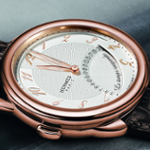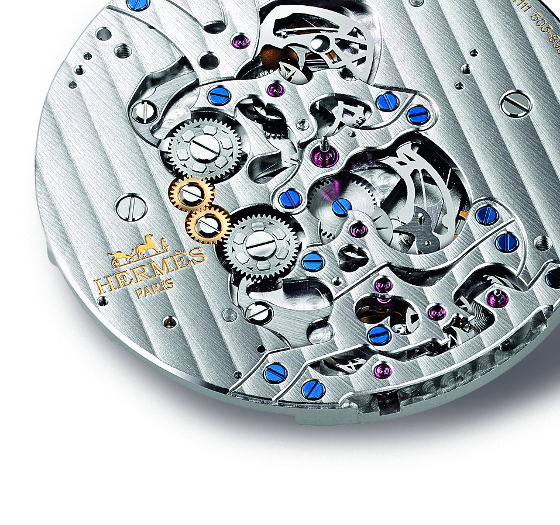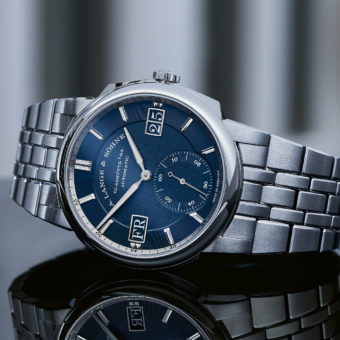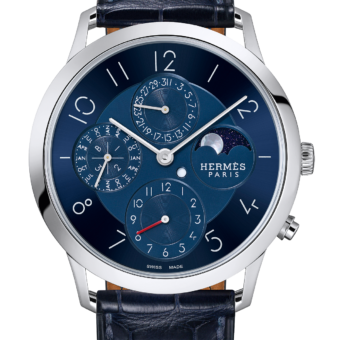
Thanks to a special module, reports Julia Knaut, the Hermès Arceau Le Temps Suspendu lets you suspend time for as long as you like. Here’s our exclusive test of the watch, with photos by OK-Photography.
We’ve all had moments that we wished could last forever: sitting by a river on a mild summer evening, strolling through a small Tuscan town or swimming in a pristine glacial lake. The Hermès Arceau Le Temps Suspendu lets its wearer capture and hold such moments by, literally, stopping time: pressing a button sends the hour and minutes hands instantly to 12 o’clock, while the date hand disappears behind the hour ring, which in its lower right quadrant is raised above the dial so that the hand will fit underneath it. For as long as its wearer desires, the watch’s hands – and with them, time itself – simply stand still (“le temps suspendu” means “suspended time”). In the meantime, the movement, an ETA 2892, continues to run. When the wearer pushes the button a second time, the hands jump forward to display the correct time.

This function was devised by a team of movement designers at Hermès under the direction of Jean-Marc Wiederrecht, founder of Agenhor, which specializes in making modules for mechanical-watch complications.
The watch has many appealing details. The dial is elegant and distinctive thanks to its different textures and levels and its curvaceous golden numerals. So is the case, which is cambered and polished and equipped with the curved lugs – the top one is sharply arched; the bottom one less so − for which this collection is named. (The collection’s name, “Arceau,” means “arc.”) The strap is made of dark brown alligator and has a rose-gold folding clasp. Even though the Le Temps Suspendu incorporates several diverse design elements, the watch makes a harmonious impression.


The craftsmanship of the hands, which are polished; the dial, with its paper-thin applied numerals; and the case, made of rose gold, is meticulous. The strap, hand-sewn and lacquered, was made by Hermès, famed for its history as a saddler. The clasp, also made of rose gold and quite sturdy, is the cherry on the sundae. It repeats the stirrup-like shape of the upper strap lug and, like the lug, is very cleanly crafted. It holds the watch securely and, thanks to its design, will not open inadvertently.

The upper drawing shows the module in its normal state; the lower in its “suspended time” mode. When the button (blue) is pressed, the cams (magenta) are decoupled from the hands because the lever that’s mounted on the switching wheels (red) presses against the rack elements (green). These move the hands to 12 o’clock and simultaneously decouple them from the cams.

The watch is easy to set. The crown is at 2 o’clock. It can be grasped readily and pulls out with little pressure. The button for “suspending time” also operates smoothly. Strap and clasp are quite user-friendly: the leather is thinner and softer on the end of the strap so that it can slip easily into the clasp and through the loops. The buttons on the clasp also move smoothly and are easy to grasp. The strap and clasp are both comfortable and never pinch or press the wrist.
The watch is a little hard to read, at least on the silver-dial version we tested, because there isn’t much contrast between the dial and its slim golden numerals. Furthermore, the pierced hands are quite narrow. The date numerals are small and thin and also somewhat difficult to make out.

Our rate test showed an average gain of just three seconds per day. The greatest deviation was a large seven seconds, which detracted from otherwise very admirable performance. All in all, our tested watch performed with only moderately acceptable rate results.
The suspended-time module is elegantly engineered. It works by means of two synchronous switching wheels: the lower switching wheel (see illustration above) controls the hands for the minutes and the date; the upper wheel commands the hour hand. These hands are controlled by three cams. If you press the button at the “9,” the cams uncouple from the hands. The levers, which are controlled by the switching wheels, simultaneously press against the racks for the hour, minutes and date hand. These racks are brought to their outermost position so the hour and minutes hand leap to the top of the dial: the hour hand a tad before the “12” and the minutes hand a tad after it. At the same time, the date hand moves toward the right and disappears under the raised segment of the hour hand between 4 and 5 o’clock. While the hands remain stationary, the watch’s balance and gear train continue to run. When the wearer presses the button again, the cams re-couple with the racks for the hands, causing the latter to leap forward and catch up with the current time and date.








Can’t see the use of such a complication. What a waste. …